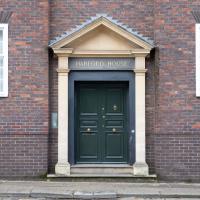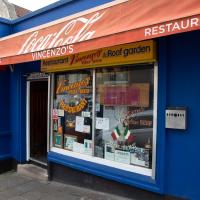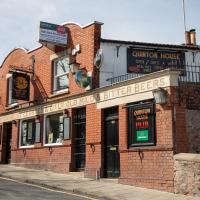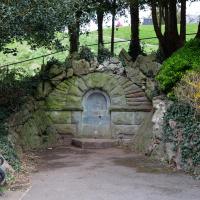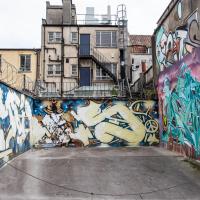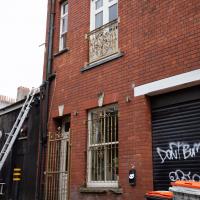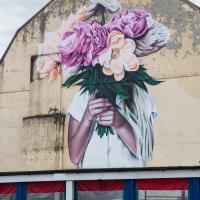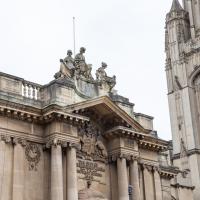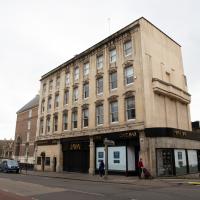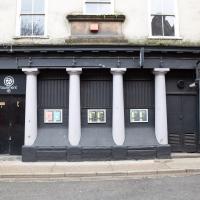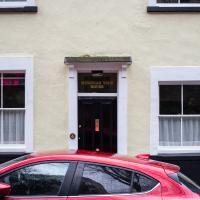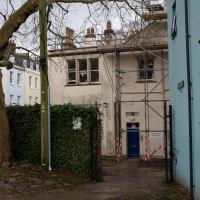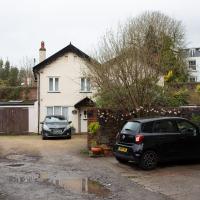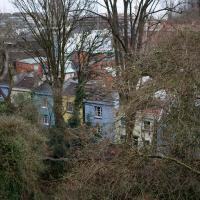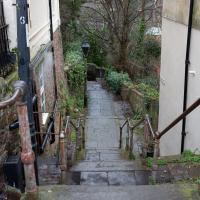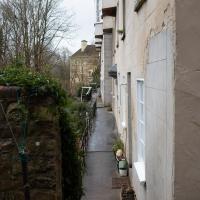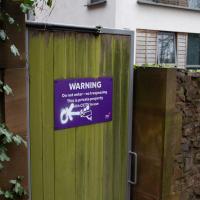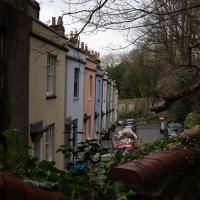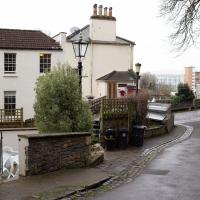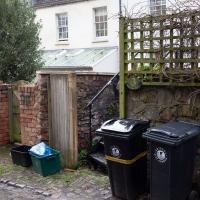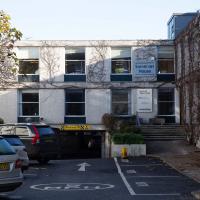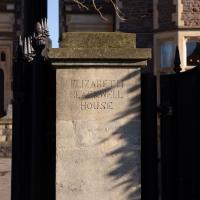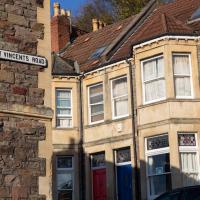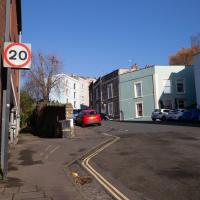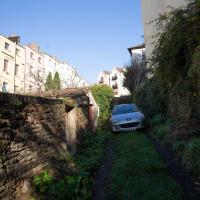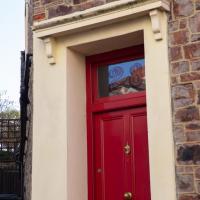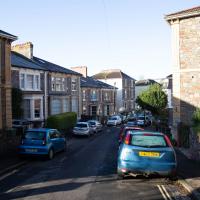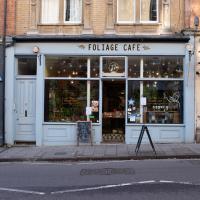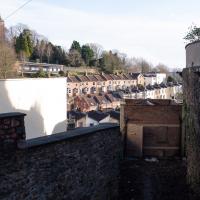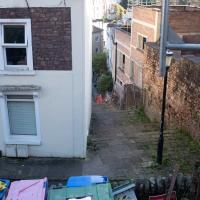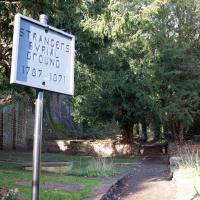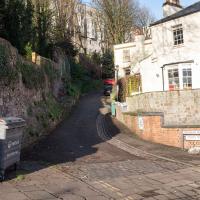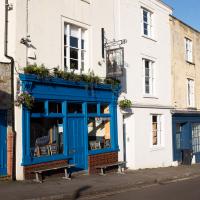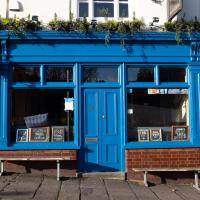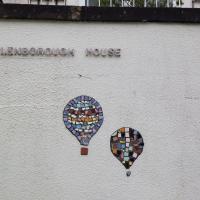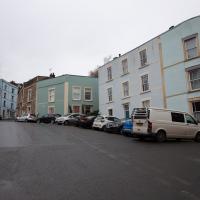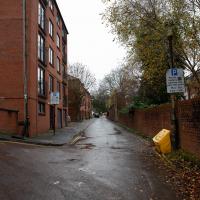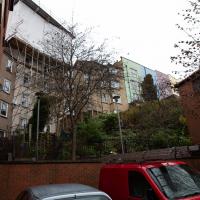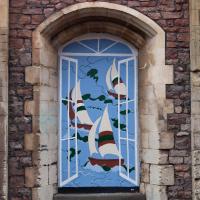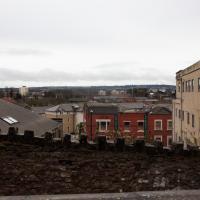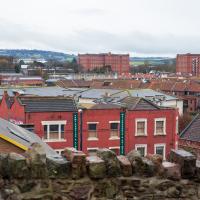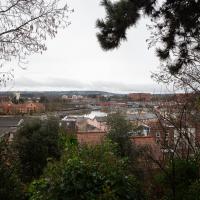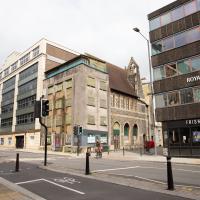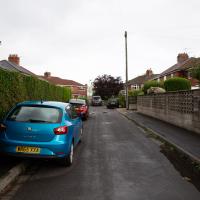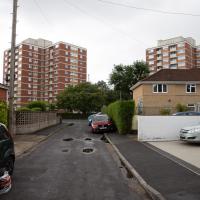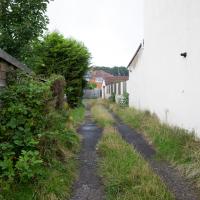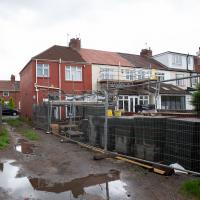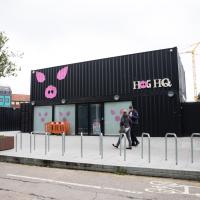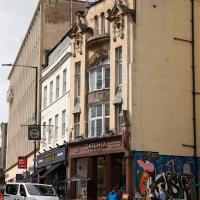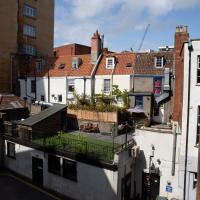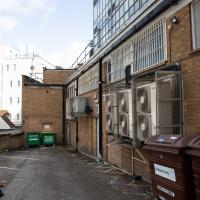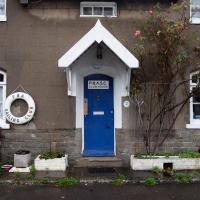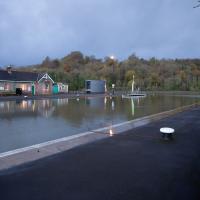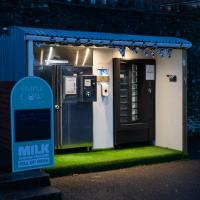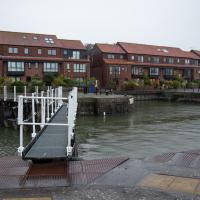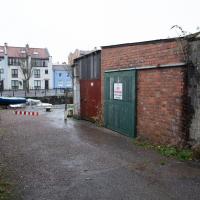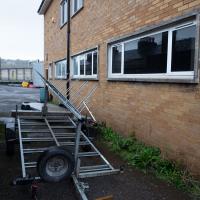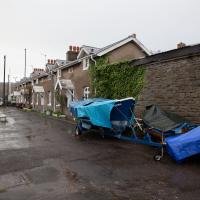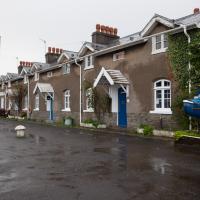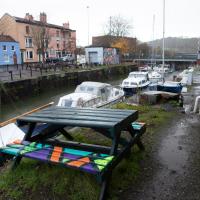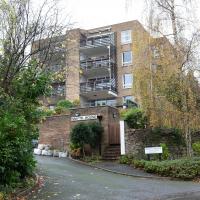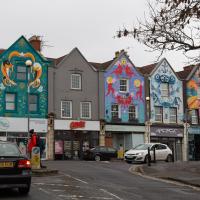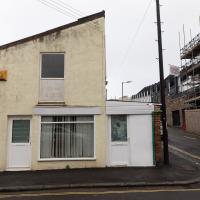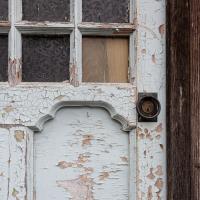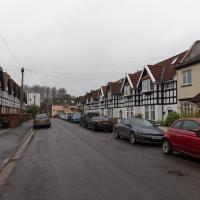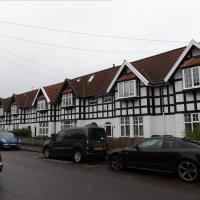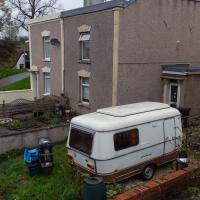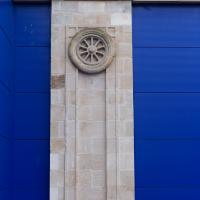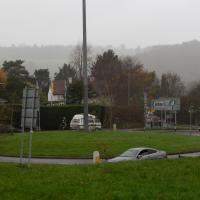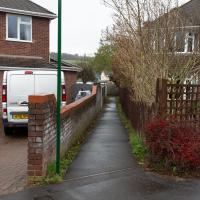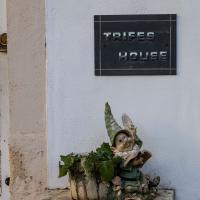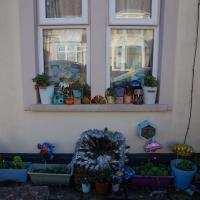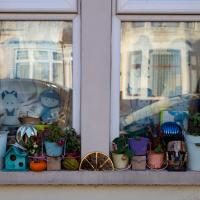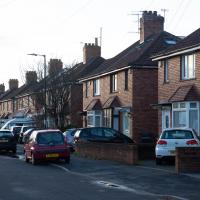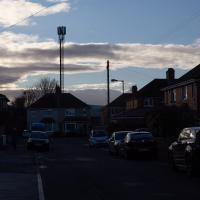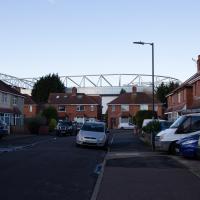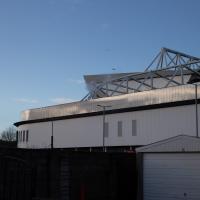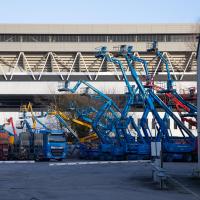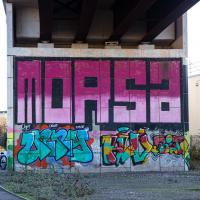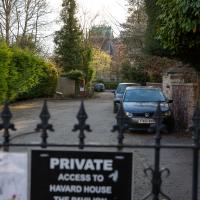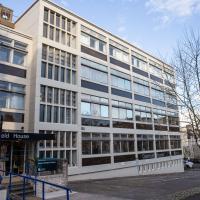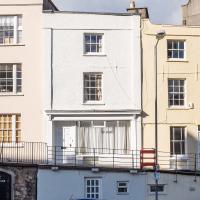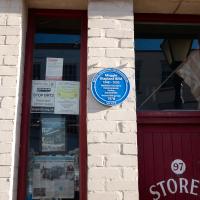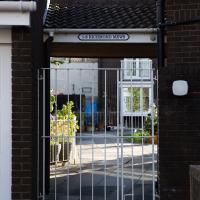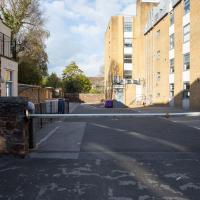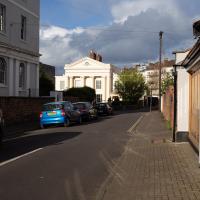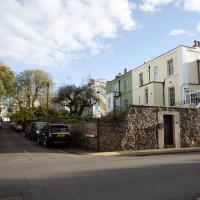Tagged: house
I got interested in Bristol's medieval water supplies after poking around near Jacobs Wells Road and Brandon Hill. It was during that research I found out about a pipe that's still there today, and, as far as I know, still actually functioning, that was originally commissioned by Carmelite monks in the 13th century. They wanted a supply of spring water from Brandon Hill to their priory on the site of what's now the Bristol Beacon—Colston Hall, as-was. It was created around 1267, and later, in 1376, extended generously with an extra "feather" pipe to St John's On The Wall, giving the pipework its modern name of "St John's Conduit".
St John's on the Wall is still there, guarding the remaining city gate at the end of Broad Street, and the outlet tap area was recently refurbished. It doesn't run continuously now, like it did when I first moved to Bristol and worked at the end of Broad Street, in the Everard Building, but I believe the pipe still functions. One day I'd like to see that tap running...
There are a few links on the web about the pipe, but by far the best thing to do is to watch this short and fascinating 1970s TV documentary called The Hidden Source, which has some footage of the actual pipe and also lots of fantastic general footage of Bristol in the seventies.
On my walk today I was actually just going to the building society in town, but I decided to trace some of the route of the Carmelite pipe, including visiting streets it runs under, like Park Street, Christmas Street, and, of course, Pipe Lane. I also went a bit out of my way to check out St James' Priory, the oldest building in Bristol, seeing as it was just around the corner from the building society.
There are far too many pictures from this walk, and my feet are now quite sore, because it was a long one. But I enjoyed it.
This is the place that still has some of the reused fixtures and fittings of the RMS Mauretania installed inside.
Meridian
17 Feb 2021
The long road between Clifton Road and Park Place—the little triangle of grass in front of the Pro-Cathedral, which also houses Quinton House pub, the Park Launderette and Mr Swantons Barbers—is one I've travelled a lot, as it's a nice route between my place and the top of Park Street, especially Ocado. It has many names along the way, even though it feels like just one continuous road. It's York Place, Tottenham Place, Meridian Place and Bruton Place before it finally spits you out onto Park Place.
It was Meridian Place I was interested in today, as I wanted to explore the set of steps that lead down from it in the direction of Jacobs Wells Road. Turns out they lead to Meridian Vale and Meridian Mews, and come out between the Strangers Burial Ground and the Eldon House, opposite the entrance to Bellevue Terrace. I liked the little terrace on Meridian Vale, though they probably don't get a lot of light in the front windows, what with Meridian Place and Tottenham Place towering above them.
On the way back home I popped into the little lane behind Regent Street that houses the Chesterfield Hospital, as I realised I'd neglected that up until now. It was... unexciting.
I don't know if they've got an official title, but seeing as they lead from Meridian Place to Meridian Lane, that's what I'm calling them.
I only just noticed what looks like a large ammonite in the wall on the left. No idea what it actually is.
Interesting! This seems to be a modern block of student flats around the back of the old Pro-Cathedral. I knew the Pro-Cathedral was student accommodation now, but I didn't know there was a gert big block of modern block behind it, too. It's well-hidden. Or I'm not very good at noticing things. One of the two.
Apparently the site is called Cathedral Park, houses 263 students, and comprises the converted cathedral, "a modern new-build and the Upper School building."
Avoiding the Accounts
26 Nov 2020
I took the day off my day job to do my accounts—or at least do enough bookkeeping to send them to my accountant. I hate doing the books. I woke up late, tired and with a headache and decided to bunk off for a walk around Cliftonwood, Clifton Village and Clifton instead, taking in a couple of good coffees along the way. Thanks, Foliage Café, and Twelve for the flat whites.
Elizabeth Blackwell, born in Bristol in 1821, was the the first female physician on the medical register of the General Medical Council, and the first woman to receive a medical degree in the United States.
The Elizabeth Blackwell Medal is awarded annually to a woman who has made significant contribution to the promotion of women in medicine
From what I've worked out so far, the use of St Vincent's name around so much of Bristol, especially Hotwells and Clifton, dervies from the ancient hermitage and chapel dedicated to St Vincent of Saragossa, which (possibly) was in Ghyston’s Cave, the cave in the rock face now accessible through a tunnel from the observatory, but at the time only by a perilous cliff climb (which I can only presume is what made it so appropriate for a hermitage.)
Why St Vincent of Saragossa? Anthony Adolph says:
It should be explained that the connection of Bristol with the Iberian wine trade led, in the Middle Ages, to Bristol’s importing of the cult of Lisbon’s patron saint, Vincent.
I have done very little real research on this so far, though, so don't take my word for any of it. I am not a historian, etc.
Strangers' Burial Ground
04 Dec 2020
I tried to find the Strangers' Burial Ground the last time was up in Clifton, but I'd not realised that Lower Clifton Hill continues further on after the turning with Constitution Hill. Sadly it was chained shut, but it still looks beautifully-maintained, perhaps by the same man referenced by this story from John Hodgson, which helped me find it. Apparently Thomas Beddoes is buried here.
Well, presumably. They needed an overflow graveyard because, rather unsurprisingly, a lot of the people ill with TB and other maladies who flocked to Bristol to sample the curative power of mildy warm spring water ended up carking it.
I think there's a way through there up to Meridian Place in Clifton Village. I'll try to find it at some point in the future.
The bloke in the sign is John Scott, 1st Earl of Eldon. Among other things, he was Lord Chancellor twice.
This is a fine, friendly little pub. I think I was first introduced to it on a Flickr meet ten or fifteen years ago.
Cliftonwood and a Secret Garden
03 Dec 2020
I love the isolation of Cliftonwood -- the geography of it, with its solid boundary of Clifton Vale to the west and Jacob's Wells Road to the east mean that you tend not to be in Cliftonwood unless you've got a reason to be there. It's not a cut-through to anywhere, at least not from side-to-side, and you can only really exit to the south on foot.
I sense that I'd be happy living in Cliftonwood -- like my bit of Hotwells, it's a quiet little area with a sort of quirky feel to it. Plus it contributes the colourful houses that are the backdrop of about half of all Bristol postcards ever made :)
I found the "secret" garden especially interesting, just for the fact that it really does feel quite secret, despite the obvious name on the gate. I've lived a half-mile from it for twenty years and I don't think I've ever noticed it before, despite exploring the area a few times.
I got curious about Bioinduction's sign down on the Hotwell Road once. According to the company's website theire mission is to "develop a precisely targetted brain pacemaker that offers new hope for the millions of sufferers... To revolutionise the treatment of cerebrovascular and neurodegenerative diseases where there is no effective drug therapy available today."
Apparently Gnodal "was a computer networking company headquartered in Bristol, UK. The company designed and sold network switches for datacenter, high-performance computing and high-frequency trading environments"
A Long Wander Of Miscellany and Magick
08 Aug 2021
This was a wide-ranging wander. I started off crossing the river to Bedminster, to walk a single little cul-de-sac, Hardy Avenue, that I'd managed to miss on at least one previous walk. Then, pausing only to explore a few back alleyways, I headed for a few destinations related mostly by the Hughes family, who I've been researching a little as part of background for a possible novel, as several of them were involved in the Stella Matutina.
However, mostly it's the artistic side of the family I wanted to explore today, as that's where most of their public history lies (as you might expect, there's often not much in the public record about the workings of an occult organisation.) First I visited College Green, where the façade of the Catch 22 Fish & Chip shop still bears the work of Catherine Edith Hughes. Then I wandered up to the top of Park Street to pop into the Clifton Arts Club's annual exhibition, as Catherine, her half-brother Donald, his wife Hope and at least two other Hugheses were members. Donald was chairman for 40 solid years; Hope was Secretary for eight, and Ellard and Margaret Hughes, two more Hughes siblings, were members along with Catherine.
Finally I walked home with a small diversion to Berkeley Square, to confirm the location of Donald Hughes's house by checking for a particular plaque by the front door.
I must admit I'm not entirely sure where all this research is really leading me, but I'm finding it quite interesting to bump across the faint lines of history that link the Hermetic Order of the Golden Dawn, founded in 1888, to modern, quotidian Bristol.
The rather derelict looking building on the corner of Prince Street and Royal Oak Avenue was at one point a Seaman's Mission & Instutue, and more recently an evangelilcal church of some kind. It was damaged during the war and seems to now be some kind of Frankenstein's monster of architecture with an odd modern frontage. The rather more together-looking (but still, frankly, unattractive!) building to the left is Prince House.
Edit to add: (19 June 2022): Know Your Place has just tweeted some amazing photos of the chapel interior (here's some more) that have just been added to the Community Layer on their incredibly useful website.
This may be a more interesting view than you'd think at first sight. Whitemead and Winterstoke House, with Southbow House out of sight on the far side, were finished in 1962, as the post-War housing crisis continued. There's a fascinating article in the Bristol Post about them, especially Whitemead House, the block on the left here, which was famously used for external scenes in Only Fools and Horses after filming moved to Bristol, standing in for the fictional Nelson Mandela House in Peckham where the Trotters lived.
The logo tells me that this is related to Pigsty, the pig-related food place on the end of Cargo 1. And apparently I'm right—this is The Jolly Hog HQ, and The Jolly Hog—butchers, and sausage specialists—own and run the Pigsty. I hadn't realised that they were such a big business.
These days it's a fish and chip shop, but it started as the Cabot Cafe.
According to this description of an etching by Alexander Heaney:
Built in 1904 for an estate agent, Walter Hughes, to the design of Latrobe & Weston, architects well known for their cinemas. Above the word ‘Café’ can just be seen the Pomegranate mosaic with enamel insets by the client's daughter, Catherine Hughes, taken from Charles Rickett's bookbinding for Oscar Wilde's A House of Pomegranates, 1891.
Caroline's Miscellany tells us:
Less bright, but equally beautiful, are the copper panels to either side. These continue the pomegranate theme and are pure Art Nouveau. Other details, by contrast, are more baroque (a mixture of styles characteristic of LaTrobe and Weston's work).
Cabot Cafe suffered damage in the Second World War. We are fortunate, then, that this intriguing facade nevertheless survived to delight us today.
I wandered into a back alleyway that I hadn't explored before.
I reckon this is the back of Denmark Street, around where Smoke and Mirrors is.
I reckon this is probably the Co-Op's air conditioning. Don't tell me I never take you anywhere exciting.
Sunday Morning
15 Nov 2020
My friend Sarah mentioned the high tide and I managed to drag myself out early, though still a little late. We nearly drowned in torrential rain, but the weather changed quickly and we ended up walking over to Bedminster in sunshine.
I have since worked out how to use the milk vending machine, and very nice milk it is, too.
Have I got the wrong listing?
Terrace of 3 houses. Dated 1831. For the Bristol Docks Company. Coursed Pennant rubble and render, party wall stacks and slate roof. Single-depth plan. Each a single storey; 3-window range. Symmetrical houses have a rubble plinth to the ground floor cill, central doorways with pitched canopies on plain brackets to a segmental-arched doorway with splayed reveals to a plain board door.
There's definitely more than three houses. On the Bristol council map of listed buildings, this is "Floating Harbour Nos. 1-5 (Consecutive) Old Dock Cottages Grade II". Colour me confused.
I don't know what industry happens in the building on the right, here, but this is definitely where the workers take a break.
Bedmo and Ashton Court
21 Nov 2020
A rather more wide-ranging weekend wander with Sarah and Vik, taking in some mock Tudor bits of Bedmo (I should note that I've subsequently been corrected to "Bemmie", but I'm an outsider and have been calling it "Bedmo" for short for decades...), a chunk of Ashton, a path up Rownham Hill called Dead Badger's Bottom(!), The Ashton Court estate, a bit of the UWE campus at Bower Ashton, and some of the Festival Way path.
I often walk through Greville Smyth park, and there's many other things in Bristol bearing the Smyth name. John Henry Greville Smyth was...
...an English naturalist and collector of natural history specimens. He is best known for his large private collection of mammals, birds, and insects kept at his stately home of Ashton Court in Bristol. On his death his wife, Lady Emily Greville Smyth, donated the bulk of the collection to the Bristol Natural History Museum, now known as Bristol Museum and Art Gallery.
But the Smyth name in general is all over this bit of Bristol, from Greviille Smyth Park outwards, which is hardly surprising given that the Smyth family home was Ashton Court, where four hundred years' worth of Smyths resided after Sir Thomas Arundel sold the place to a John Smyth in 1545, a few years after being gifted it by Henry VIII.
Bedminster, Ashton, Ashton Court sunset walk
12 Dec 2020
A walk with Sarah focusing on Ashton and the surrounds, taken on a day with really nice light around sunset. Just what I needed.
Fury as huge phone mast is erected without planning permission just a few feet from residents' homes, according to the Evening Post.
An Evening Wander to the Gallows
06 Apr 2021
I'd originally intended just to pop up to the area around Alma Road, where I'd missed a few streets on earlier wanders. It was such a nice evening, though, I decided to extend my walk up to the very top of Pembroke Road, just outside my one mile radius, to take a few snaps of something intriguing I'd found in my researches.
I've driven, walked and jogged past the little triangle of land at the top of Pembroke road a great deal in my time in Bristol, but I didn't know that it used to be the site of a gibbet, in fact that the road itself there used to be called Gallows Acre Lane. According to the Durdham Down history trail, by Francis Greenacre (an excellent name for a Downs researcher!) among other sources:
...it was below this quarry near the top of Pembroke Road, once called Gallows Acre Lane, that a gibbet stood. It was sometimes occupied by those who had committed robberies on the Downs and was last used in 1783 to hang Shenkin Protheroe for the murder of a drover. Stories quickly spread that he descended from the gibbet at midnight every night and stalked through Clifton. Such was the alarm that his body was cut down
and buried.
Also very close to this little triangle of land was one of the gates of the extensive turnpike system...
Anyway. Along the way I encountered a wooden tortoise and a real squirrel, among other things. It was a good walk, and more light in the evenings means I can move my wanders out of the ticking countdown clock of work lunch-hours and be a bit more leisurely.
Another snap to remind myself that while it looks like a road on the map, I don't have to walk it because it's private. This is one of the many access roads to Clifton College.
A Bristol Medical School building. And yet another giant building in Bristol you could come within a few hundred yards of thousands of times without ever actually knowing it was there. I think I've only seen it a couple of times before, and both times I was deliberately exploring because I was a bit bored of my normal route.
I came across this photo of 5 Wellington Terrace back when it was the Gaping Goose, two doors down from the Portcullis, and decided to snap the site as it is today. Interesting comparison!
The late, great Maggie Shapland was a familiar feature to anyone interested in historical industry in Bristol.
I think the first time I saw her was on an Open Doors Day for the Clifton Rocks railway, the disused funicular from the Avon Gorge Hotel down to near the landing stage in Hotwells, and the last time was when she was helping to restore Brunel's Other Bridge at Howard's Lock.
Both times I think she'd driven there in one or other of the classic cars she maintained. Sometimes when the garage door here was open on the way past you could sneak a look at the collection.
The last thing I saw her drive was this Moss kit car.
An amazing person by all accounts, I never knew that we shared the profession of "Database Consultant"...
From the satellite view on Google Maps, it looks like it's a little courtyard surrounded by houses on all sides.
I only snapped this so I'd remember that I didn't miss this "street", but that it was a private car park.
Well, I suppose that's actually the back of Pembroke Road, but it's on Buckingham Vale.
